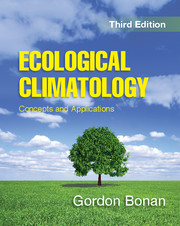Book contents
- Frontmatter
- Dedication
- Contents
- Preface
- 1 Ecosystems and Climate
- Part I The Earth System
- Part II Global Physical Climatology
- Part III Hydrometeorology
- Part IV Biometeorology
- Part V Terrestrial Plant Ecology
- 18 Plant Strategies
- 19 Populations and Communities
- 20 Ecosystems
- 21 Soil Biogeochemistry
- 22 Vegetation Dynamics
- 23 Landscapes and Disturbances
- 24 Global Biogeography
- Part VI Terrestrial Forcings and Feedbacks
- Appendix
- Index
- Plate section
- References
19 - Populations and Communities
from Part V - Terrestrial Plant Ecology
Published online by Cambridge University Press: 05 November 2015
- Frontmatter
- Dedication
- Contents
- Preface
- 1 Ecosystems and Climate
- Part I The Earth System
- Part II Global Physical Climatology
- Part III Hydrometeorology
- Part IV Biometeorology
- Part V Terrestrial Plant Ecology
- 18 Plant Strategies
- 19 Populations and Communities
- 20 Ecosystems
- 21 Soil Biogeochemistry
- 22 Vegetation Dynamics
- 23 Landscapes and Disturbances
- 24 Global Biogeography
- Part VI Terrestrial Forcings and Feedbacks
- Appendix
- Index
- Plate section
- References
Summary
Chapter Summary
This chapter continues the discussion of the preceding chapter, focusing on the arrangement of individual plants in populations and multiple species in communities. The concept of a niche is central to the understanding of the organization of species across the landscape. A niche represents the components of the environment to which a species is adapted. Evolutionary pressures have lead to niche differentiation in which species differ in preferences for resources and have different functional roles in communities. This is seen in the dispersion of species along resource gradients. Though vegetation can be classified into distinct communities of species, most communities intergrade continuously and exist within a continuum of populations. Species do not group along environmental gradients in distinct natural associations, but rather arrange individualistically according to their own physiology and life history patterns. The manner in which plant populations associate in recognizable communities is critical to understanding the response of vegetation to climate change. A plant community that exists today may have no analog under different climate. Particular species enter and dominate a given locale based on prevailing climate and other environmental conditions, the occurrence of disturbance such as fire, and their own life history patterns.
Niche and Species Abundance
The environment is spatially heterogeneous, varying in light, temperature, soil moisture, nutrients, and other conditions. Just as physiological processes vary depending on the specific environmental conditions encountered by a plant, so too do plant species thrive over a specific range of environmental conditions. Biological performance for a particular species is typically optimal at some level of an environmental condition (e.g., soil moisture) and decreases with conditions less than or greater than optimal (Figure 19.1). In two dimensions such as soil moisture and temperature, the environmental space within which a species thrives is represented by an area formed by the intersection of moisture and temperature tolerances. Growth, for example, may be optimal over some narrow range of moisture and temperature and may decrease with conditions that are wetter or drier than optimum or soils that are warmer or colder than optimum. In three dimensions, a multidimensional cube represents the environmental conditions over which a particular species can grow.
- Type
- Chapter
- Information
- Ecological ClimatologyConcepts and Applications, pp. 315 - 327Publisher: Cambridge University PressPrint publication year: 2015



